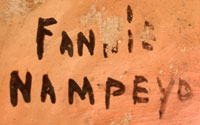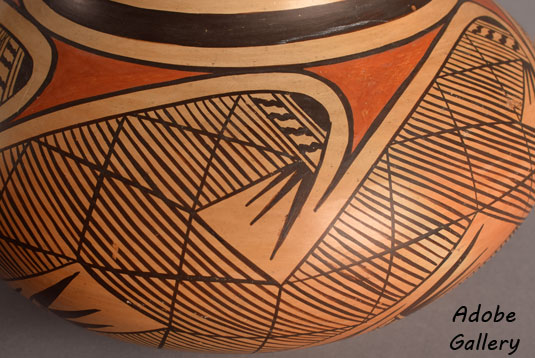Hopi-Tewa Migration Pattern Sikyatki Revival Seed Jar by Fannie Nampeyo [SOLD]
+ Add to my watchlist Forward to Friend
- Category: Modern
- Origin: Hopi Pueblo, Hopituh Shi-nu-mu
- Medium: clay, pigment
- Size: 5” height x 7-½” diameter
- Item # C4486P SOLD
This polychrome jar, created by Hopi potter Fannie Nampeyo, is a beautifully crafted piece with strong use of traditional Sikyatki designs. The “migration pattern,” which represents the migration of the Hopi people through four worlds, was one of Fannie’s favorite designs. Whether it was her personal favorite or whether she produced it because it was collectors’ favorite is unknown, but it is the one she seems to have used most often. With this piece, Fannie executed as fine a migration pattern as we’ve seen from the gifted potter. The piece is similar in shape and quality to those which we know to have been made in the 1950s. This period is generally regarded as Fannie’s strongest.
 The jar’s shape is exceptional. It is well-balanced and symmetrical with a simple flared rim. Its color is a gorgeous tan, with a few bright spots that are almost orange. Its primary design is a wide band of the migration pattern, with fine lines completed precisely and consistently. Below and above this wide band are thin, bold framing lines in dark brown. Wide brown bands encircle the neck and below the design. The shape, design, and color of this jar work beautifully together, resulting in an exemplary Fannie Nampeyo jar. The piece is signed Fannie Nampeyo.
The jar’s shape is exceptional. It is well-balanced and symmetrical with a simple flared rim. Its color is a gorgeous tan, with a few bright spots that are almost orange. Its primary design is a wide band of the migration pattern, with fine lines completed precisely and consistently. Below and above this wide band are thin, bold framing lines in dark brown. Wide brown bands encircle the neck and below the design. The shape, design, and color of this jar work beautifully together, resulting in an exemplary Fannie Nampeyo jar. The piece is signed Fannie Nampeyo.
Fannie Polacca Nampeyo (1900-1987) was a Hopi-Tewa potter who was a daughter of Nampeyo of Hano and Lesou. She had two sisters, Annie Healing Nampeyo and Nellie Douma Nampeyo. They were all Corn Clan members. Lesou was a Tobacco Clan, but clan inheritance comes from the mother. Fannie had 7 children—Thomas, Elva, Tonita, Iris, Leah, Harold, and Ellsworth—all of whom were potters. Fannie won her first Blue Ribbon in 1961 from the Museum of Northern Arizona at the annual Hopi Show. Her pottery was selected for several museum exhibits in the 1990s. Since she was the youngest daughter of Nampeyo and Lesou, she was better known, personally, by many collectors, most of whom never met Annie or Nellie. She was still actively making pottery as late as the mid-1980s. She passed away in 1987.
Condition: very good condition, minor abrasions on the underside.
Provenance: this Hopi-Tewa Migration Pattern Sikyatki Revival Seed Jar by Fannie Nampeyo is from the estate of a gentleman from Santa Fe
Recommended Reading: Fourteen Families in Pueblo Pottery by Rick Dillingham
Relative Links: Hopi Pueblo, Nampeyo of Hano, Annie Healing Nampeyo, Nellie Nampeyo Douma, Thomas, Elva, Tonita, Iris, Leah, Contemporary Pottery, Fannie Polacca Nampeyo, Hopi-Tewa Potter

- Category: Modern
- Origin: Hopi Pueblo, Hopituh Shi-nu-mu
- Medium: clay, pigment
- Size: 5” height x 7-½” diameter
- Item # C4486P SOLD



